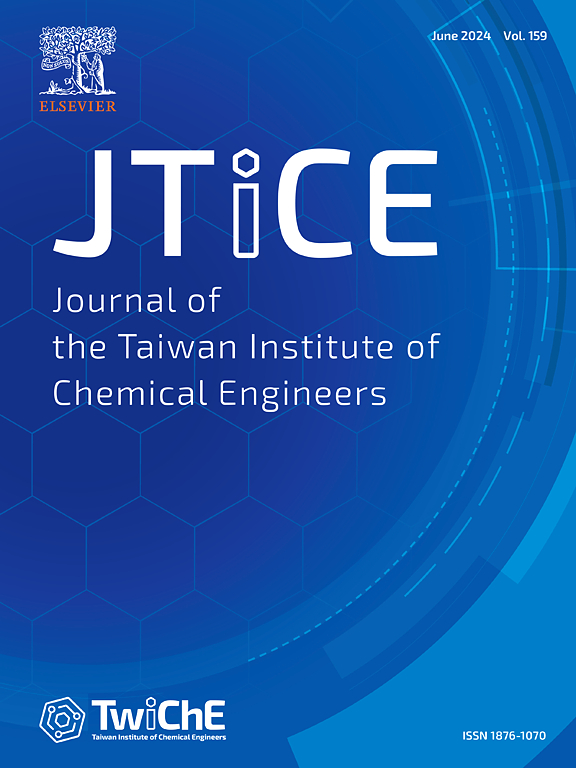Electrochemical corrosion mitigation of copper in 3.5 wt.% NaCl solution using cerium (III) chloride salt
IF 5.5
3区 工程技术
Q1 ENGINEERING, CHEMICAL
Journal of the Taiwan Institute of Chemical Engineers
Pub Date : 2025-07-15
DOI:10.1016/j.jtice.2025.106270
引用次数: 0
Abstract
Background
Rare earth salts have been known as a promising environmentally friendly inhibitor for various metals and their alloy due to their ability to prevent electrochemical corrosion reactions by forming a rare earth oxide/hydroxide film. This film may result from the hydrolysis of rare earth trivalent ions which are strongly promoted via electrochemical corrosion reactions. However, a rare earth salt, particularly cerium (III) chloride (CeCl3), has not been demonstrated its inhibitory efficiency for copper and its alloy in chloride environment. Indeed, it motivates this study to understand behaviors of CeCl3 in improving the corrosion resistance of copper. The work comprehensively investigates electrochemical properties of copper in the 3.5 wt.% NaCl solution without and with varying concentrations of CeCl3.
Methods
Electrochemical properties of the copper as immersed in the 3.5 wt.% NaCl solution are characterized by both non-destructive (open circuit potential (OCP) and electrochemical impedance spectroscopy (EIS)) and destructive techniques (potentiodynamic polarization (PD), cathodic polarization (CP), dynamic electrochemical impedance spectroscopy (DEIS), and wire beam electrode (WBE)) for 24 hours. In addition, post-corrosion surfaces of the target electrodes after 24-hour immersion in the testing solution without and with the addition of CeCl3 are characterized using scanning electron microscopy (SEM), energy-dispersive X-ray spectroscopy (EDS mapping), and X-ray photoelectron spectroscopy (XPS).
Significant Findings
CeCl3 demonstrates its effectiveness as a potential inhibitor, with the highest inhibition efficiency of 76.16 ± 0.49% at 1.22 mM. Based on analyzing electrochemical results and elemental analysis, this work clarifies that copper-based products form on the copper surface along with CeCuOx to develop a composite multilayer, where cerium-based compounds can effectively enhance the stability of the protective film by restricting diffusion occurring at the interface between the electrode and electrolyte. In addition, localized corrosion inhibition of CeCl3 is obviously observed via random distribution of minor anodes and major cathodes on the copper surface. Therefore, the finding highlights the novelty of the work and contributes to understanding inhibition mechanism of CeCl3 for protecting copper in the 3.5 wt.% NaCl environment.

氯化铈在3.5 wt.% NaCl溶液中电化学缓蚀铜的研究
稀土盐被认为是一种很有前途的环境友好型金属及其合金缓蚀剂,因为它们能够通过形成稀土氧化物/氢氧化物膜来防止电化学腐蚀反应。该膜可能是由电化学腐蚀反应强烈促进的稀土三价离子水解形成的。然而,稀土盐,特别是氯化铈(CeCl3)在氯化物环境中对铜及其合金的抑制效果尚未得到证实。事实上,这激发了本研究了解CeCl3在提高铜耐腐蚀性方面的行为。本文研究了铜在3.5 wt.% NaCl溶液中不含CeCl3和不同浓度CeCl3的电化学性能。方法采用非破坏性技术(开路电位(OCP)和电化学阻抗谱(EIS))和破坏性技术(动电位极化(PD)、阴极极化(CP)、动态电化学阻抗谱(DEIS)和线束电极(WBE))对铜在3.5 wt.% NaCl溶液中浸泡24小时的电化学性能进行表征。此外,使用扫描电子显微镜(SEM)、能谱x射线能谱(EDS mapping)和x射线光电子能谱(XPS)对目标电极在不添加CeCl3和添加CeCl3的测试溶液中浸泡24小时后的腐蚀后表面进行了表征。结果表明,scecl3是一种潜在的缓蚀剂,在1.22 mM处的缓蚀效率最高,为76.16±0.49%。基于电化学结果分析和元素分析,本工作明确了铜基产物与cecox一起在铜表面形成复合多层。其中铈基化合物可以通过限制电极和电解质之间界面处发生的扩散来有效地增强保护膜的稳定性。此外,通过在铜表面随机分布的小阳极和主阴极,可以明显观察到CeCl3的局部缓蚀作用。因此,这一发现突出了这项工作的新颖性,有助于理解CeCl3在3.5% wt.% NaCl环境中保护铜的抑制机制。
本文章由计算机程序翻译,如有差异,请以英文原文为准。
求助全文
约1分钟内获得全文
求助全文
来源期刊
CiteScore
9.10
自引率
14.00%
发文量
362
审稿时长
35 days
期刊介绍:
Journal of the Taiwan Institute of Chemical Engineers (formerly known as Journal of the Chinese Institute of Chemical Engineers) publishes original works, from fundamental principles to practical applications, in the broad field of chemical engineering with special focus on three aspects: Chemical and Biomolecular Science and Technology, Energy and Environmental Science and Technology, and Materials Science and Technology. Authors should choose for their manuscript an appropriate aspect section and a few related classifications when submitting to the journal online.

 求助内容:
求助内容: 应助结果提醒方式:
应助结果提醒方式:


